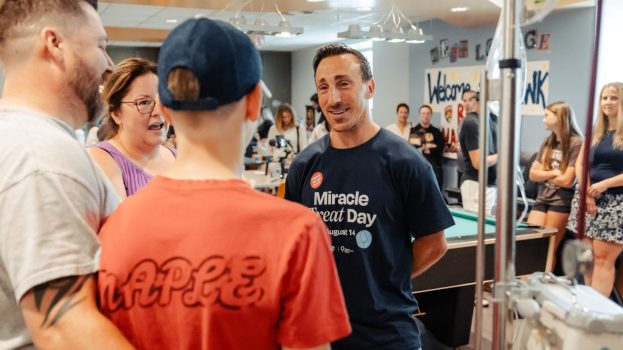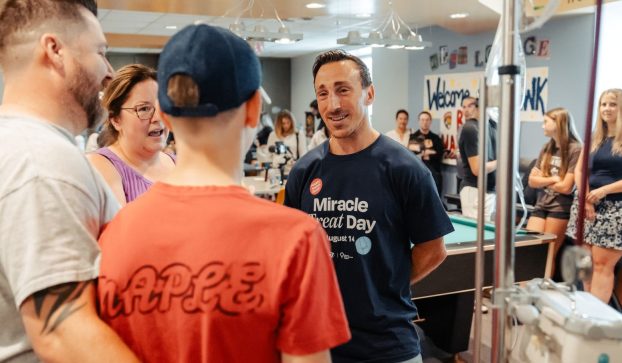If you weren’t among the fortunate people who received a Personal Video Recorder over the holidays, then prime time at your house is likely still that time of day when networks schedule ‘hit’ TV programming to keep you pinned to the sofa until your eyelids finally lose their battle with gravity.
Or maybe, overwhelmed with getting back into the flow of post-holiday life, you are simply missing all the good stuff on television.
If, on the other hand, you did receive a PVR from Santa (or someone closer to you), then you have joined the growing population of North Americans for whom prime time is not a time of day, but a state of mind. It has been this way in my home for about a year and a half. The Personal Video Recorder has forever changed the way we watch TV.
Our PVR permits us to enjoy a multi-hundred channel universe where we can elude the stranglehold of the network schedule. We never miss our favourite shows. We watch more champagne, less beer, and we watch it when we want.
Gone are the stacks of speciously labeled VHS tapes cluttering shelves. We no longer deal with the complexities of programming the VCR. Press a couple buttons on the remote control, and voîlà! I’ll have every episode of 24 for the entire season. I grab Six Feet Under, The Osbournes, West Wing, CSI, and any film available on my television subscription that I care to store in the 30-hour hard drive for some sub-zero Sunday when going outside seems irrational, even to a Canadian.
More importantly, as parents of two girls, aged 8 and 6, the PVR has added a very interesting and positive dimension to the television viewing experience for their mother and me.
It has effectively removed the ‘program conflict’ problem from the nuclear family equation. Before the PVR crossed our threshold, I was likely to hear at least once a week, ‘Not NOW! Are you CRAZY, Dad? Hit List just started!’ Since the advent of the PVR, my wife and I can more effectively ration the quantity and quality of television viewed by our children. We have also supplanted the broadcast network as the scheduling authority. Hit List is recorded on the hard drive, so it’s always available.
Our goal as parents is to capture programming appropriate for our kids, and to make it available to watch once more important things have been accomplished. It should be a destination, not a journey without end or purpose. We can prioritize the math and French homework, reading, practising piano, cleaning the bird cage and scheduling family time. We can get pyjamas on and get hair and teeth brushed, before sitting down as a family to watch what they have chosen before bed time.
Tonight’s selection: The Crocodile Hunter.
And the kids get this technology: To them, it’s just another digital file to click on and store for later viewing. This one just happens to be an 30-minute digital video file featuring nasty, poisonous reptiles trying to kill a hyper Australian with more passion than brains whom, it is presumed, has a death wish or a great deal of life insurance.
As they squeeze the paste onto their toothbrushes I am struck with a parallel. This non-linear time shifting, this new On Demand viewing behaviour, is like so much techno-toothpaste escaping from the tube. It’s never, ever, going back in. Once one has experienced the kind of control, customization and convenience possible with a PVR, why would one ever surrender that to a television network again? (Okay, maybe to watch the Super Bowl. But that’s it.)
When I am watching a TV without PVR functionality, or when I am at the local googleplex taking in a film, I find myself reaching for a remote to rewind a compelling scene, a stunt or an elusive fragment of dialogue. I am annoyed when I realize that I cannot exert this control over all my film and video content. I have come to regard life before PVR as a distant and primitive period when the network was in charge and all snacks had to be made within a three minute commercial pod.
But wait, there’s more: My kids like to watch their favourite films about 25 times, or until they have committed the entire script to memory. The most recent high-rotation title in our home was Monsters Inc. I ordered it on pay-per-view for a couple of toonies and promptly recorded it on the PVR. Now the girls can watch it 25 hundred times if they want, and I saved a small fortune in DVD rentals and late fees.
To observe them watching time-shifted TV is to catch a glimpse into the future of television viewing behaviour. They use the 30-second skip feature to blow right through the ads for ‘stupid toys for stupid boys,’ but will pause, rewind, and even record ads for things that interest them; toys for girls, film trailers, promos for upcoming shows, anything with a horse in it, or just amusing, entertaining advertising.
The PVR is more than a compass to help you navigate the multi-hundred channel universe. It’s more than a filter for your programs or a recording device. It is a boon for the time-impoverished among us. I can cook dinner while the NFL playoff game, on pause, buffers onto the hard drive.
The basic prep done, I use the 30-second skip feature to leap-frog from snap to snap, over the tired clichés and vacuous banter of the commentators. I just watch the plays, not the huddles. I watch the action, not the players standing around contemplating their stock portfolios. I can pare the best of the game down to an exciting 40 minutes and still get the family to the dinner table.
And the commercials? Sure, I skip ads; I always did skip some ads by leaving the room, starting a conversation, grazing channels or the refrigerator. With the PVR, I rewind to watch certain advertising that I find entertaining or interesting. Marketers should take heart; the PVR isn’t necessarily the Great Satan some in the press have reported it to be.
Early studies have, in fact, shown that television viewing increases with the introduction into the home of a PVR. In the Media Experts iTV Lab we have identified three key and interdependent factors that affect ad exposure to the PVR user. They are: the overall increase in tuning, the rate at which the user skips commercials, and the ratio of live to on-demand tuning. Given the right confluence of circumstances, these factors can actually result in an increase in commercial exposure. (See Lab Reports at www.itvlab.tv.)
The PVR not only connects viewers to their favourite content, it can connect content, including commercial content, to the right viewer. It has certainly connected me to marketing that I would not otherwise have seen had I not recorded it. Incremental viewing means incremental ad exposure. And that is good news for programmers and marketers alike.
They should both feel as secure as I do in the knowledge that when the final contest is played out in some murky jungle river bed, I will be there – albeit on my schedule – to see the final score and the ads. Crocodiles 1, Hunter 0. Go Crocs, Go!
Ian MacLean is VP of The Media Experts iTV Lab in Montreal. He can be reached at: ianm@mediaexperts.com.























